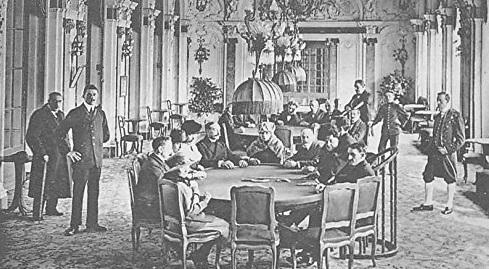Baccarat History
Why is Baccarat so popular? Some might point to the obvious like it’s easy to play, or it’s beneficial to players with its low house edge, or James Bond made it look cool. But surely it must take more than just a simplistic gameplay for it to stand the test of time and transition from the 15th century soldier bivouacs to the glamorous casinos of Las Vegas and today’s cutting-edge online platforms with dazzling live dealers. Let’s first have a look at how it all started.
Early Origins of Baccarat – Chinese Games and Ancient Roman Rituals
Despite it being one of the most popular and oldest card games across the world, Baccarat’s origin remains unclear. The first written record of the game is from the 19th century, so all other accounts about it prior are mere hearsay. Still, the possible scenarios of how the game came into existence are quite interesting. According to one, Baccarat may have derived in part from some non-card games such as the Chinese Pai Gow game which was played with tiles instead of cards. This is mainly based on some correlation between the meaning of Pai Gow (make nine) and nine being the best score in Baccarat as well. It cannot be substantiated by historic evidence, however.

Another presumption, again based on the number nine, traces Baccarat’s roots to Ancient Rome and a ritual in which vestal virgins would cast a dice to determine their faith. Rolling 8 or 9 signified the future of a high priestess, 6 or 7 meant that her vestal virgin would have to be revoked, while any other number would cost her her life as she had to walk into the sea and drown. Even if the number nine was somehow acquired in baccarat through some of these games and rituals, it still doesn’t answer why baccarat is played with cards and not dice today. So, let’s fast forward to the late 13th century when Marco Polo returned to Italy from his expeditions.
Humble Beginnings in Italy
The “play of cards at tables” was first described in a French manuscript dated to the 1330s. Before the invention of the printing press, card games were hardly a popular activity mainly due to the scarcity of playing cards. They had to be either hand-painted or block printed by using a carved wooden block as a stamp – a Chinese technique used for Pai Gow tiles which Marco Polo introduced to Italy in the late 1290s. With the invention of the printing press, playing cards became more widely spread as they were printed in packs of 78. Known as The Devil’s Picture Books, playing cards were now more abundant. New card games proliferated and older games were adapted to be played with cards, Baccarat being one of them.
Although Baccarat is often considered to have originated in France, historic evidence points to Italy as the birthplace of the game. Tarrochi was a card game played in Italy in the 1300s and although there’s no proven correlation between it and Baccarat, Tarrochi could in fact be the predecessor of all card games. Felix Falguiere was an Italian man who invented baccarat (or at least is considered to have invented its modern form) using Tarot cards. Another game popular in Italy at the time – Macao, which was played to the total of nine – is often referred to as Italian Baccarat and could be the game from which modern-day Baccarat was derived.
Le Her is another game that could be the origin of the oldest form of Baccarat, as they’re both fixed-number games aiming for the highest score. Le Her was a card game played by two players – each dealt only one card. The cards had values 1 to 13, Kings being the highest rank and the instant winner. Each player could exchange their card if it was anything else than a King which is similar to the additional card drawing in Baccarat.
In the 19th century, another game was pointed out as a predecessor of Baccarat when Hoyle’s Official Rules of Card linked it to the Vingt-et-un games, which is French for 21 and yes, thus ultimately bringing the behemoth Blackjack forward in the family tree. The game described in this book is actually Baccarat en Banque. In the 1911’s edition of the Hoyle books, The Official Rules of Card Games Up to Date, there is a clear distinction between Baccarat en Banque and Chemin de Fer and they’re listed as separate games.
Baccarat in France – A Noble albeit Illegal Pastime
Baccarat is widely regarded as a French game so let’s have a look at how the Baccarat situation in La République unfolded. As the stories go, Baccarat was introduced in France by soldiers returning from the Italian conflicts during the 1490s. Supposedly, the game quickly became popular with the French nobility. Two versions of Baccarat – Baccarat en Banque (Baccarat Deux Tableux) and the non-banking Chemin de Fer were played during the Napoleonic era. Such was the interest they garnered that even after Louis Phillip made casinos illegal in 1837, they continued to be played in houses running underground gambling operations outside the law, while retaining popularity in Europe.
Considering the phrase Chemin de Fer means “iron way” or “railway” we could make an educated guess that this version became popular after 1832 when the first railroad in France was opened. However, there are no period documents that actually prove it – the name could have been added later on, for all we know – so we just have to assume that Baccarat en Banque is the older version. The first mention of Baccarat was in 1847 when Charles Van-Tenac included a 13-page mathematical analysis of the game – the first printed one ever – in his Album des jeux.

Across the Atlantic and Over the Pacific – Baccarat Arrives in America
If you research the origin of Baccarat in the United States, you will find articles and documents that point to 1911 as the year of the first Baccarat game played in an American gambling establishment. This statement is backed by John Scarne, Steve Forte, and other respected authors and card games experts who have come to grips with subject of Baccarat. However, these statements and assumptions are easily rebuffed by some period newspaper publications.
The first printed record of Baccarat being played in the United States was in 1871. An article in the New York Times described the Club-house at Long Branch where visitors were flocking around the “faro spread, the roulette table and the Baccarat board.” Another article again in the New York Times, this time from 1899 chronicled the arrest of 30 Frenchmen playing Baccarat, which means that the game was being played in the United States decades earlier than originally thought. Despite these mentions, Baccarat is generally considered to have made its American debut in the early 1900s. John Scarne describes Chemin de Fer being played in 1911 in New York, adding that it was nowhere near as popular as the other banking games Blackjack and Craps that were played by American servicemen during WWI.
First Reports of Baccarat in the USA
Although the early references in the New York Times describe Baccarat en Banque and not Chemin de Fer, it’s still an interesting fact that Baccarat was played in the United States decades earlier than originally considered. Still, Baccarat was completely absent from the Assembly Bill which legalized gambling in 1931. When the Sands opened a table in 1958, the version that was played was Chemin de Fer (often referred to as Chemmy). It was a non-banking game where the casino collected a rake on the winning bets which is probably what Mark Twain was referring to when he said he would have stayed at the table if he could borrow the croupier’s oar. Baccarat wasn’t a major casino game until 1959 when Tommy Renzoni brought a new version called Punto Banco to Las Vegas. Originally developed at the Mar del Plata casino in Argentina in the early 1950s, this version is the game Baccarat played today at most casinos in the USA, the UK, and Australia.
| Popular Online Baccarat Versions | |||||
|---|---|---|---|---|---|
| Game | Features | Bet Limits | Developer | Live | Play At |
| Progressive Baccarat |
|
5 - 250 | Playtech | yes | Betwinner Casino |
| Baccarat Control Squeeze |
|
25 - 25.000 | Evolution Gaming | yes | 22bet Casino |
| Grand Baccarat |
|
3 - 100 | Playtech | yes | Betwinner Casino |
| Speed Baccarat |
|
1 - 5.000 | Evolution Gaming | yes | 22bet Casino |
| Multi-Bet Baccarat Gold |
|
5 - 200 | Microgaming | no | Betwinner Casino |
| Baccarat High Limits |
|
1 - 500 | Microgaming | no | 22bet Casino |
Baccarat in Nevada – First Games at the Vegas Strip
On November 20th 1959, the Las Vegas Sands made casino history as it opened its first Punto Banco table. The evening took off steeped in promotional glitz and glam but came to a rough end, with the casino losing a quarter of a million dollars. Fortunately, the owners weren’t put off by the shaky start and decided to keep the game long enough to make a sustainable profit. In the decades to follow, Baccarat retained an air of exclusivity as in the 1970s, there were only 15 tables at the entire Vegas strip, most of which were open part-time, so the only way to get a seat was to be rich or famous, preferably both.
Popularity of the Game Today
The early Baccarat games played at the Vegas strip in the 1960s were not exactly the Punto Banco variation Renzoni had brought from South America. The initial version of Baccarat offered a side bet on natural hands and no Tie bets. Instead of chips, casinos accepted cash wagers and for the sake of convenience, the dealers would apply a soap-like substance on the bills that made them lay flat on the table. The wax bills, however, weren’t accepted in some banks and shops, so by the early 1970s most Baccarat tables were operating with chips. But that wasn’t the only difference from today’s gameplay and overall ambience.
Part of the allure of the game was due to the glamorous shills – lovely young ladies who actually played on the table with minimum wagers, drawing the cards from the shoe and the interest of gamblers, as well. Nowadays, you won’t see such casino employees except at some poker casinos. Baccarat has changed a lot through the years and its popularity in Asia has rendered it more vibrant and dynamic, albeit heavily reliant on superstition, spawning different variations with fast-paced gameplay, additional features, and side bets to take the excitement up a notch.
In the 2010s baccarat was one of the casino games that got the fastest adoption online. Nowadays it is almost universal across big and small online casino operators that they offer live dealer games to their clients on desktop and mobile devices. If you are looking to enjoy such games, you can look at the best online baccarat casinos and decide where you would want to play!
| 22bet Casino | Live Side Bets | $1,500 | Play Here | |
| Betwinner Casino | Live Side Bets | $1,500 | Play Here | |
| Melbet Casino | Live Side Bets | $1,500 | Play Here |
*T&Cs apply